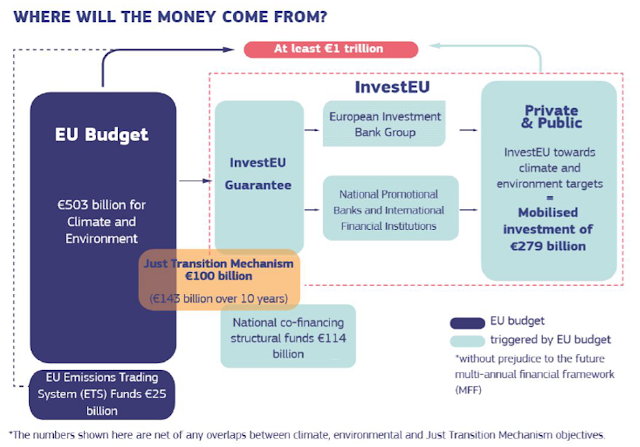The Three Big Issues of COP 25 in Madrid
 The UN Climate Change Conference COP 25 is currently on its way in Madrid. In this post we explain the relationship with the Paris Agreement, take a look at 3 main issues that COP 25 in Madrid needs to tackle and provide an assessment of possible solutions. The three main tasks for the Madrid Conference are: 1) New and Improved National Contributions 2) Trading of Climate Change Mitigation Measures 3) Implementation of the Warsaw-Mechanism.
The UN Climate Change Conference COP 25 is currently on its way in Madrid. In this post we explain the relationship with the Paris Agreement, take a look at 3 main issues that COP 25 in Madrid needs to tackle and provide an assessment of possible solutions. The three main tasks for the Madrid Conference are: 1) New and Improved National Contributions 2) Trading of Climate Change Mitigation Measures 3) Implementation of the Warsaw-Mechanism.1) New and Improved National Contributions
It is well-known that countries signed a pledge in December 2015 in Paris to make efforts for global warming not to get beyond 1.5 degrees celsius, compared to pre-industrial times. The core-mechanism to reach this aim are national contributions. However, while the aim is binding the individual contributions are voluntary - there is no binding mechanism on who has to do what and when in the Agreement. This was a political compromise. To counter that, the states at least agreed to review the climate goals and national contributions every five years and (crucially) make them ever-more demanding. This means that next year new and improved national contributions should be brought to the table and the Madrid COP needs to engage in preparations for that.
Given the experience over the last four years, we know that the currently pledged national contributions are by far not sufficient to keep global warming at the level of 1.5 degree celsius. Negotiators hope that if some states lead with the revision of national contributions others might follow step-by-step, as they would, otherwise, get an image problem. However, experience has shown that this might be too optimistic: Russia only managed to ratify the Paris Agreement in September 2019, the US officially notified the other countries of its withdrawal in November 2019 and Germany is coming to the table with a climate package that is barely sufficient to even meet its current national targets.
2) Trading of Climate Change Mitigation Measures
While several regions of the world adopted some sort of an Emissions Trading Scheme, a global system for the trade of climate efforts is lacking. The Kyoto Protocol featured the Clean Development Mechanism, which, however, never worked sufficiently. Now a new mechanism shall be negotiated. The idea being that, for instance, Switzerland could finance a wind-farm in Argentina. The climate change mitigation effect of the wind-farm would count towards national climate goals in Switzerland. The advantage for a country like Argentina would be that it could get help from foreign investors with the energy transition and the advantage for Switzerland would be that wind-farms in Argentina might be cheaper to build than wind-farms in Switzerland. The underlying line of reason is that climate change is a global issue, so solutions should also work across countries.
There are, however, three main disadvantages, as the example of the Clean Development Mechanism highlighted. First, it could lead to the situation that, in our example, Switzerland would be able to reach its climate targets, but in fact they did not change the structure of their industry and economy in Switzerland itself. Questions about the true sustainability of this are, thus, being asked. Second, such a mechanism is based on a complicated control-mechanism concerning sells and purchases of CO2 certificates. Third, countries like Argentina, in our example, could simply play down their abilities to engage in climate change mitigation matters, just to get domestic projects, that would have been on the agenda anyway, financed by someone else.
3) Implementation of the Warsaw Mechanism
In 2013 the Warsaw Mechanism was created to address loss and damage associated with impacts of climate change, including extreme events and slow onset events in developing countries that are particularly vulnerable to the adverse effects of climate change. The idea is to transfer money from the Global North to the Global South to support those countries that are most adversely affected by climate change. In most cases these are poor countries, which contributed less to man-made climate change than industrialized countries. It would, thus, be a question of justice to have moneys allocated for that specific purpose - not just as general payment or donation.
The issue here is that this pre-Paris mechanism needs to be brought fully into line with the Paris Agreement. While this might sound like a formal issue, it is pivotal to countries of the global north that this is not viewed as some sort of `confession of guilt´- as such a confession could trigger liability and instigate further claims.The Paris Agreement itself excluded the possibility to interpret such payments as `confessions of guilt´, but there are other, concrete questions about implementation, such as: who is the first to bring down their emissions to net-zero? Who has to pay how much money to whom precisely? Every country is currently allowed to determine by itself which payments it deems fair and just in its climate goals.



This comment has been removed by a blog administrator.
ReplyDelete